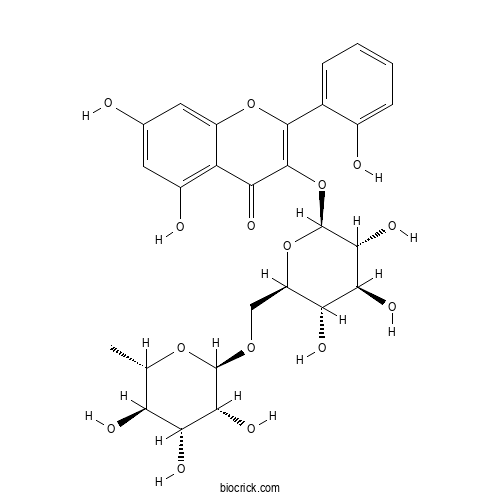DatiscinCAS# 16310-92-2 |

Quality Control & MSDS
3D structure
Package In Stock
Number of papers citing our products

| Cas No. | 16310-92-2 | SDF | Download SDF |
| PubChem ID | 10054207 | Appearance | Powder |
| Formula | C27H30O15 | M.Wt | 594.5 |
| Type of Compound | Flavonoids | Storage | Desiccate at -20°C |
| Solubility | Soluble in Chloroform,Dichloromethane,Ethyl Acetate,DMSO,Acetone,etc. | ||
| Chemical Name | 5,7-dihydroxy-2-(2-hydroxyphenyl)-3-[(2S,3R,4S,5S,6R)-3,4,5-trihydroxy-6-[[(2R,3R,4R,5R,6S)-3,4,5-trihydroxy-6-methyloxan-2-yl]oxymethyl]oxan-2-yl]oxychromen-4-one | ||
| SMILES | CC1C(C(C(C(O1)OCC2C(C(C(C(O2)OC3=C(OC4=CC(=CC(=C4C3=O)O)O)C5=CC=CC=C5O)O)O)O)O)O)O | ||
| Standard InChIKey | BJJCTXDEJUWVIC-QHWHWDPRSA-N | ||
| Standard InChI | InChI=1S/C27H30O15/c1-9-17(31)20(34)22(36)26(39-9)38-8-15-18(32)21(35)23(37)27(41-15)42-25-19(33)16-13(30)6-10(28)7-14(16)40-24(25)11-4-2-3-5-12(11)29/h2-7,9,15,17-18,20-23,26-32,34-37H,8H2,1H3/t9-,15+,17-,18+,20+,21-,22+,23+,26+,27-/m0/s1 | ||
| General tips | For obtaining a higher solubility , please warm the tube at 37 ℃ and shake it in the ultrasonic bath for a while.Stock solution can be stored below -20℃ for several months. We recommend that you prepare and use the solution on the same day. However, if the test schedule requires, the stock solutions can be prepared in advance, and the stock solution must be sealed and stored below -20℃. In general, the stock solution can be kept for several months. Before use, we recommend that you leave the vial at room temperature for at least an hour before opening it. |
||
| About Packaging | 1. The packaging of the product may be reversed during transportation, cause the high purity compounds to adhere to the neck or cap of the vial.Take the vail out of its packaging and shake gently until the compounds fall to the bottom of the vial. 2. For liquid products, please centrifuge at 500xg to gather the liquid to the bottom of the vial. 3. Try to avoid loss or contamination during the experiment. |
||
| Shipping Condition | Packaging according to customer requirements(5mg, 10mg, 20mg and more). Ship via FedEx, DHL, UPS, EMS or other couriers with RT, or blue ice upon request. | ||
| Description | Reference standards. | |||||

Datiscin Dilution Calculator

Datiscin Molarity Calculator
| 1 mg | 5 mg | 10 mg | 20 mg | 25 mg | |
| 1 mM | 1.6821 mL | 8.4104 mL | 16.8209 mL | 33.6417 mL | 42.0521 mL |
| 5 mM | 0.3364 mL | 1.6821 mL | 3.3642 mL | 6.7283 mL | 8.4104 mL |
| 10 mM | 0.1682 mL | 0.841 mL | 1.6821 mL | 3.3642 mL | 4.2052 mL |
| 50 mM | 0.0336 mL | 0.1682 mL | 0.3364 mL | 0.6728 mL | 0.841 mL |
| 100 mM | 0.0168 mL | 0.0841 mL | 0.1682 mL | 0.3364 mL | 0.4205 mL |
| * Note: If you are in the process of experiment, it's necessary to make the dilution ratios of the samples. The dilution data above is only for reference. Normally, it's can get a better solubility within lower of Concentrations. | |||||

Calcutta University

University of Minnesota

University of Maryland School of Medicine

University of Illinois at Chicago

The Ohio State University

University of Zurich

Harvard University

Colorado State University

Auburn University

Yale University

Worcester Polytechnic Institute

Washington State University

Stanford University

University of Leipzig

Universidade da Beira Interior

The Institute of Cancer Research

Heidelberg University

University of Amsterdam

University of Auckland

TsingHua University

The University of Michigan

Miami University

DRURY University

Jilin University

Fudan University

Wuhan University

Sun Yat-sen University

Universite de Paris

Deemed University

Auckland University

The University of Tokyo

Korea University
- 15-Methoxy-16-oxo-15,16H-strictic acid
Catalog No.:BCN9868
CAS No.:1356388-38-9
- 1,2-Dimethoxybenzene
Catalog No.:BCN9867
CAS No.:91-16-7
- Tropic acid
Catalog No.:BCN9866
CAS No.:529-64-6
- 4-(4-Methoxyphenyl)-2-butanone
Catalog No.:BCN9865
CAS No.:104-20-1
- ICG-001
Catalog No.:BCN9864
CAS No.:780757-88-2
- 3,29-O-Dibenzoyloxykarounidiol
Catalog No.:BCN9863
CAS No.:389122-01-4
- Somnifericin
Catalog No.:BCN9862
CAS No.:173693-57-7
- Solanidine
Catalog No.:BCN9861
CAS No.:80-78-4
- Sphenanlignan
Catalog No.:BCN9860
CAS No.:866347-36-6
- Vanillic acid glucoside
Catalog No.:BCN9859
CAS No.:32142-31-7
- alpha-Peltatin
Catalog No.:BCN9858
CAS No.:568-53-6
- 5,6-Benzoflavone
Catalog No.:BCN9857
CAS No.:6051-87-2
- Cannabiscitrin
Catalog No.:BCN9870
CAS No.:520-14-9
- Lappaconine
Catalog No.:BCN9871
CAS No.:23943-93-3
- Condurango glycoside A
Catalog No.:BCN9872
CAS No.:11051-90-4
- 2-(4-Hydroxybenzal)acetophenone
Catalog No.:BCN9873
CAS No.:20426-12-4
- Norharman
Catalog No.:BCN9874
CAS No.:244-63-3
- Syringetin
Catalog No.:BCN9875
CAS No.:4423-37-4
- 4-Hydroxyisophthalic acid
Catalog No.:BCN9876
CAS No.:636-46-4
- Lyciumamide B
Catalog No.:BCN9877
CAS No.:1647111-41-8
- Tricaprin
Catalog No.:BCN9878
CAS No.:621-71-6
- Dihydroquinine
Catalog No.:BCN9879
CAS No.:522-66-7
- Cymarin
Catalog No.:BCN9880
CAS No.:508-77-0
- 5,7-Dihydroxy 3,3',4',5',6,8-hexamethoxyflavone
Catalog No.:BCN9881
CAS No.:96887-18-2
Two novel disaccharides, rutinose and methylrutinose, are involved in carbon metabolism in Datisca glomerata.[Pubmed:19915863]
Planta. 2010 Feb;231(3):507-21.
Datisca glomerata forms nitrogen-fixing root nodules in symbiosis with soil actinomycetes from the genus Frankia. Analysis of sugars in roots, nodules and leaves of D. glomerata revealed the presence of two novel compounds that were identified as alpha-L-rhamnopyranoside-(1 --> 6)-D-glucose (rutinose) and alpha-L-rhamnopyranoside-(1 --> 6)-1-O-beta-D-methylglucose (methylrutinose). Rutinose has been found previously as a/the glycoside part of several flavonoid glycosides, e.g. rutin, also of Datiscin, the main flavonoid of Datisca cannabina, but had not been reported as free sugar. Time course analyses suggest that both rutinose and methylrutinose might play a role in transient carbon storage in sink organs and, to a lesser extent, in source leaves. Their concentrations show that they can accumulate in the vacuole. Rutinose, but not methylrutinose, was accepted as a substrate by the tonoplast disaccharide transporter SUT4 from Arabidopsis. In vivo (14)C-labeling and the study of uptake of exogenous sucrose and rutinose from the leaf apoplast showed that neither rutinose nor methylrutinose appreciably participate in phloem translocation of carbon from source to sink organs, despite rutinose being found in the apoplast at significant levels. A model for sugar metabolism in D. glomerata is presented.


